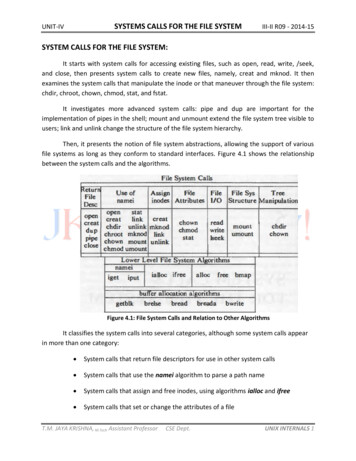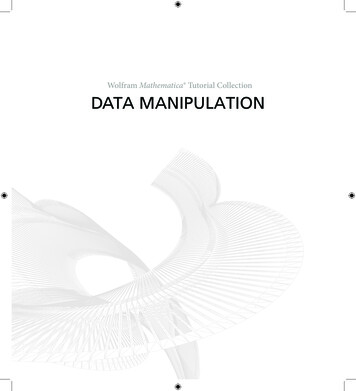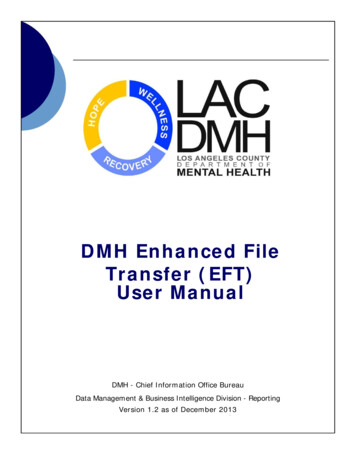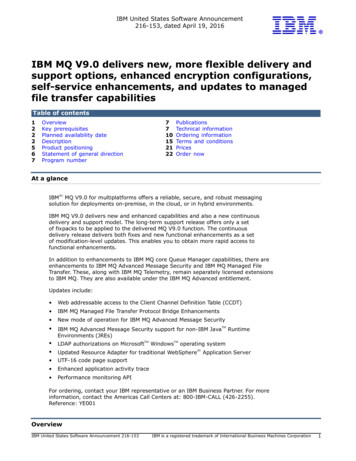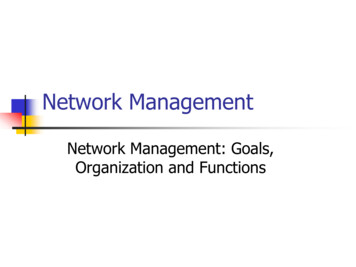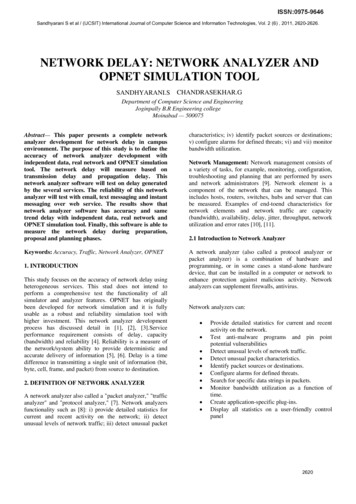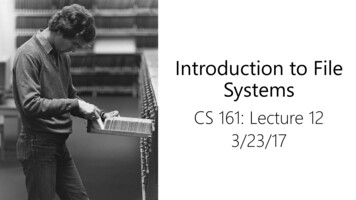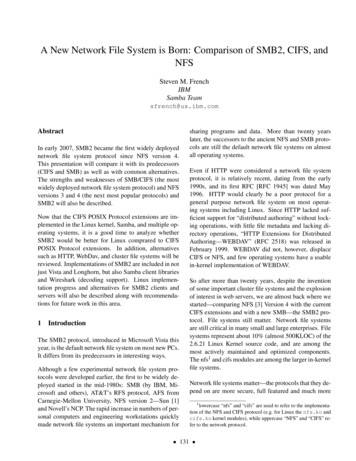
Transcription
A New Network File System is Born: Comparison of SMB2, CIFS, andNFSSteven M. FrenchIBMSamba Teamsfrench@us.ibm.comAbstractIn early 2007, SMB2 became the first widely deployednetwork file system protocol since NFS version 4.This presentation will compare it with its predecessors(CIFS and SMB) as well as with common alternatives.The strengths and weaknesses of SMB/CIFS (the mostwidely deployed network file system protocol) and NFSversions 3 and 4 (the next most popular protocols) andSMB2 will also be described.Now that the CIFS POSIX Protocol extensions are implemented in the Linux kernel, Samba, and multiple operating systems, it is a good time to analyze whetherSMB2 would be better for Linux comprared to CIFSPOSIX Protocol extensions. In addition, alternativessuch as HTTP, WebDav, and cluster file systems will bereviewed. Implementations of SMB2 are included in notjust Vista and Longhorn, but also Samba client librariesand Wireshark (decoding support). Linux implementation progress and alternatives for SMB2 clients andservers will also be described along with recommendations for future work in this area.1IntroductionThe SMB2 protocol, introduced in Microsoft Vista thisyear, is the default network file system on most new PCs.It differs from its predecessors in interesting ways.Although a few experimental network file system protocols were developed earlier, the first to be widely deployed started in the mid-1980s: SMB (by IBM, Microsoft and others), AT&T’s RFS protocol, AFS fromCarnegie-Mellon University, NFS version 2—Sun [1]and Novell’s NCP. The rapid increase in numbers of personal computers and engineering workstations quicklymade network file systems an important mechanism forsharing programs and data. More than twenty yearslater, the successors to the ancient NFS and SMB protocols are still the default network file systems on almostall operating systems.Even if HTTP were considered a network file systemprotocol, it is relatively recent, dating from the early1990s, and its first RFC [RFC 1945] was dated May1996. HTTP would clearly be a poor protocol for ageneral purpose network file system on most operating systems including Linux. Since HTTP lacked sufficient support for “distributed authoring” without locking operations, with little file metadata and lacking directory operations, “HTTP Extensions for DistributedAuthoring—WEBDAV” (RFC 2518) was released inFebruary 1999. WEBDAV did not, however, displaceCIFS or NFS, and few operating systems have a usablein-kernel implementation of WEBDAV.So after more than twenty years, despite the inventionof some important cluster file systems and the explosionof interest in web servers, we are almost back where westarted—comparing NFS [3] Version 4 with the currentCIFS extensions and with a new SMB—the SMB2 protocol. File systems still matter. Network file systemsare still critical in many small and large enterprises. Filesystems represent about 10% (almost 500KLOC) of the2.6.21 Linux Kernel source code, and are among themost actively maintained and optimized components.The nfs1 and cifs modules are among the larger in-kernelfile systems.Network file systems matter—the protocols that they depend on are more secure, full featured and much more1 lowercase “nfs” and “cifs” are used to refer to the implementation of the NFS and CIFS protocol (e.g. for Linux the nfs.ko andcifs.ko kernel modules), while uppercase “NFS” and “CIFS” refer to the network protocol. 131
132 A New Network File System is Born: Comparison of SMB2, CIFS, and NFScomplex than their ancestors. Some of the better NAS2implementations can perform as well as SAN and cluster file systems for key workloads.2Network File System CharacteristicsNetwork protocols can be considered to be layered.Network file system protocols are the top layer—farremoved from the physical devices such as Ethernetadapters that send bits over the wire. In the Open System Interconnection (OSI) model, network file systemprotocols would be considered as layer 6 and 7 (“Presentation” and “Application”) protocols. Network filesystem protocols rely on lower level transport protocols(e.g. TCP) for reliable delivery of the network file systems protocol data units (PDUs), or include intermediate layers (as NFS has done with SunRPC) to ensurereliable delivery.Network file system protocols share some fundamentalcharacteristics that distinguish them from other “application level” protocols. Network file system clients andservers (and the closely related Network Attached Storage, NAS, servers) differ in key ways from cluster filesystems and web browsers/servers: Files vs. Blocks or Objects: This distinction is easyto overlook when comparing network file systemprotocols with network block devices, cluster filesystems and SANs. Network file systems read andwrite files not blocks of storage on a device. A fileis more abstract—a container for a sequential seriesof bytes. A file is seekable. A file conventionallycontains useful metadata such as ACLs or other security information, timestamps and size. Networkfile systems request data by file handle or filenameor identifier, while cluster file systems operate onraw blocks of data. Network file system protocolsare therefore more abstract, less sensitive to diskformat, and can more easily leverage file ownership and security information. Network file system protocol operations match local file system entry points: Network file systemprotocol operations closely mirror the function layering of the file system layer (VFS) of the operating2 NetworkAttached Storage (NAS) servers are closely related tonetwork file servers.system on the client. Network file system operations on the wire often match one to one with theabstract VFS operations (read, write, open, close,create, rename, delete) required by the operatingsystem. The OS/2 heritage of early SMB/CIFS implementations and the Solaris heritage of NFS arevisible in a few network file system requests. Directory Hierarchy: Most network file systems assume a hierarchical namespace for file and directory objects and the directories that contain them. Server room vs. intranet vs. Internet: Modern network file system protocols have security and performance features that make them usable outsideof the server room (while many cluster file systems are awkward to deploy securely across multiple sites). Despite this, HTTP and primitive FTPare still the most commonly used choices for filetransfers over the Internet. Extensions to NFS version 4 and CIFS (DFS) allow construction of aglobal hierarchical namespace facilitating transparent failover and easier configuration. Application optimization: Because the pattern ofnetwork file system protocol requests often moreclosely matches the requests made by the application than would be the case for a SAN, and sincethe security and process context of most application requests can be easily determined, network filesystem servers and NAS servers can do interestingoptimizations. Transparency: Network file systems attempt toprovide local remote transparency so that local applications detect little or no difference betweenrunning over a network file system and a local filesystem. Heterogeneity: Network file system clients andservers are often implemented on quite differentoperating systems—clients access files without regard to their on-disk format. In most large enterprises, client machines running quite different operating systems access the same data on the sameserver at the same time. The CIFS (or NFS) network file system client that comes by default withtheir operating system neither knows nor caresabout the operating system of the server. Sambaserver has been ported to dozens of operating systems, yet the server operating system is mostly
2007 Linux Symposium, Volume One 133transparent to SMB/CIFS clients. Network file systems are everywhere, yet are not always seen whenrunning in multi-tier storage environments. Theyoften provide consistent file access under large webservers or database servers or media servers. A network file system server such as Samba can easilyexport data on other network file systems, on removable media (CD or DVD), or on a local file system (ext3, XFS, JFS)—and with far more flexibility than is possible with most cluster file systems.Network file systems differ in fundamental ways fromweb clients/servers and cluster file systems.2.1History of SMB ProtocolThe SMB protocol was invented by Dr. Barry Feigenbaum of IBM’s Boca Raton laboratory during the earlydevelopment of personal computer operating systemsoftware. It was briefly named after his initials (“BAF”)before changing the protocol name to “Server MessageBlock” or SMB. IBM published the initial SMB Specification book at the 1984 IBM PC Conference. Afew years later a companion document, a detailed LANTechnical Reference for the NetBIOS protocol (whichwas used to transport SMB frames), was published.An alternative transport mechanism using TCP/IP ratherthan the Netbeui frames protocol was documented inRFCs 1001 and 1002 in 1987.Microsoft, with early assistance from Intel and 3Com,periodically released documents describing new dialectsof the SMB protocol. The LANMAN1.0 SMB dialectbecame the default SMB dialect used by OS/2. At leasttwo other dialects were added to subsequent OS/2 versions.In 1992, X/Open CAE Specification C209 provied better documentation for this increasingly important standard. The SMB protocol was not only the defaultnetwork file system for DOS and Windows, but alsofor OS/2. IBM added Kerberos and Directory integration to the SMB protocol in its DCE DSS projectin the early 1990s. A few years later Microsoft alsoadded Kerberos security to their SMB security negotiation to their Windows 2000 products. Microsoft’s Kerberos authentication encapsulated service tickets usingSPNEGO in a new SMB SessionSetup variant, ratherthan using the original SecPkgX mechanism used byearlier SMB implementations (which had been documented by X/Open). The SMB protocol increasinglywas used for purposes other than file serving, including remote server administration, network printing, networking messaging, locating network resources and security management. For these purposes, support for various network interprocess communication mechanismswas added to the SMB protocol including: Mailslots,Named Pipes, and the LANMAN RPC. Eventually morecomplex IPC mechanisms were built allowing encapsulating DCE/RPC traffic over SMB (even supportingcomplex object models such as DCOM).In the mid 1990s, the SMBFS file system for Linux wasdeveloped. Leach and Naik authored various CIFS IETFDrafts in 1997, but soon CIFS Documentation activitymoved to SNIA. Soon thereafter CIFS implementationswere completed for various operating systems includingOS/400 and HP/UX. The CIFS VFS for Linux was included in the Linux 2.6 kernel. After nearly four years,the SNIA CIFS Technical Reference [4] was releasedin 2002, and included not just Microsoft extensions toCIFS, but also CIFS Unix and Mac Extensions.In 2003 an additional set of CIFS Unix Extensions wasproposed, and Linux and Samba prototype implementations were begun. By 2005, Linux client and Sambaserver had added support for POSIX ACLs,3 POSIX4path names, a request to return all information neededby statfs. Support for very large read requests and verylarge write responses was also added.In April 2006, support for POSIX (rather than Windowslike) byte range lock semantics were added to the Sambaserver and Linux cifs client (Linux Kernel 2.6.17). Additional CIFS extensions were proposed to allow file I/Oto be better POSIX compliant. In late 2006, and early2007, joint work among four companies and the Sambateam to define additional POSIX extensions to the CIFSprotocol led to creation of a CIFS Unix Extensions wiki,as well as implementations of these new extensions [8]3 “POSIXACLs” are not part of the official POSIX API. POSIX1003.1e draft 17 was abandoned before standardization.4 In this paper, “POSIX” refers narrowly to the file API semantics that a POSIX-compliant operating system needs to implement.When the file system uses the CIFS network file system protocol,providing POSIX-like file API behavior to applications requires extensions to the CIFS network protocol. The CIFS “POSIX” Protocol Extensions are not part of the POSIX standard, rather a set ofextensions to the network file system protocol to make it easier fornetwork file system implementations to provide POSIX-like file APIsemantics.
134 A New Network File System is Born: Comparison of SMB2, CIFS, and NFSNFS VERSION 2 DIR15READDIR16STATFS17New NFS VERSION 3 FSINFO19PATHCONF20COMMIT21in the Linux CIFS client and Samba server (Mac clientand others in progress). The CIFS protocol continues toevolve, with security and clustering extensions amongthe suggestions for the next round of extensions. As thetechnical documentation of these extensions improves,more formal documentation is being considered.2.2History of NFS ProtocolNFS version 1 was not widely distributed, but NFS version 2 became popular in the 1980s, and was documented in RFC 1094 in 1989. Approximately 10 yearsafter NFS version 2, NFS version 3 was developed. Itwas documented by Sun in RFC 1813 citerfc1813 in1995. Eight years later RFC 3530 defined NFS version 4 (obsoleting the earlier RFC 3010, and completing a nearly five year standardization process). An extension to NFS version 3, “WebNFS,” documented bySun in 1996, attempted to show the performance advantages of a network file system for Internet file traffic insome workloads (over HTTP). The discussion of WebNFS increased the pressure on other network file systems to perform better over the Internet, and may havebeen a factor in the renaming of the SMB protocol—from “Server Message Block” to “Common Internet FileSystem.” Related to the work on NFS version 4 wasan improvement to the SunRPC layer that NFS usesto transport its PDUs. The improved RPCSECGSS allowed support for Kerberos for authentication (as doesCIFS), and allows negotiation of security features including whether to sign (for data integrity) or seal (fordata privacy) all NFS traffic from a particular client to aparticular server. The NFS working group is developingadditional extensions to NFS (NFS version 4.1, pNFS,NFS over RDMA, and improvements to NFS’s supportfor a global namespace).The following shows new protocol operations introduced by NFS protocol versions 3 and 4:3New NFS Version 4 34SETCLIENTID35SETCLIENTID-CONFIRM 36VERIFY37RELEASE-LOCKOWNER 39Current Network File System AlternativesToday there are a variety of network file systems included in the Linux kernel, which support various protocols including: NFS, SMB/CIFS, NCP, AFS, and Plan9.In addition there are two cluster file systems now in themainline Linux kernel: OCFS2 and GFS2. A few popular kernel cluster file systems for Linux that are notin mainline are Lustre and IBM’s GPFS. The cifs andnfs file system clients for Linux are surprisingly similar in size (between 20 and 30 thousand lines of code)and change rate. The most common SMB/CIFS serverfor Linux is Samba, which is significantly larger thanthe Linux NFS server in size and scope. The most common Linux NFS server is of course nfsd, implementedsubstantially in kernel.Windows Vista also includes support for variousnetwork file system protocols including SMB/CIFS,SMB2, and NFS.4SMB2 Under the HoodThe SMB2 protocol differs [7] from the SMB and CIFSprotocols in the following ways: The SMB header is expanded to 64 bytes, and better aligned. This allows for increased limits on the
2007 Linux Symposium, Volume One 135number of active connections (uid and tids) as wellas the number of process ids (pids). The SMB header signature string is no longer0xFF followed by “SMB” but rather 0xFE and then“SMB.” In the early 1990s, LANtastic did a similar change in signature string (in that case from“SMB” to “SNB”) to distinguish their requestsfrom SMB requests. Most operations are handle based, leaving Create (Open/Create/OpenDirectory) as the only pathbased operation. Many redundant and/or obsolete commands havebeen eliminated. The file handle has been increased to 64 bits. Better support for symlinks has been added. Windows Services for Unix did not have native supportfor symlinks, but emulated them. Various improvements to DFS and other miscellaneous areas of the protocol that will become usablewhen new servers are available. “Durable file handles” [10] allowing easier reconnection after temporary network failure. Larger maximum operation sizes, and improvedcompound operation (“AndX”) support also havebeen claimed but not proved.Currently 19 SMB2 commands are veFindNotifyGetInfoSetInfoBreakMany of the infolevels used by the GetInfo/SetInfo commands will be familiar to those who have worked withCIFS.5POSIX Conformance5.1NFSNFS version 3 defined 21 network file system operations(four more than NFS version 2) roughly correspondingto common VFS (Virtual File System) entry points thatUnix-like operating systems require. NFS versions 2and 3 were intended to be idempotent (stateless), andthus had difficulty preserving POSIX semantics. Withthe addition of a stateful lock daemon, an NFS version 3client could achieve better application compatibility, butstill can behave differently [6] than local file systems inat least four areas:1. Rename of an open file. For example, the silly rename approach often used by nfs clients for renaming open files could cause rm -rf to fail.2. Deleting an existing file or directory can appear tofail (as if the file were not present) if the request isretransmitted.3. Byte range lock security (Since these services aredistinct from the nfs server, both lockd and statdhave had problems in this area).4. write semantics (when caching was done on theclient).NFS also required additional protocol extensions to beable to support POSIX ACLs, and also lacked support for xattrs (OS/2 EAs), creation time (birth time),nanosecond timestamps, and certain file flags (immutable, append-only etc.). Confusingly, the NFS protocol lacked a file open and close operation until NFSversion 4, and thus could only implement a weak cacheconsistency model.5.2NFSv4NFS version 4, borrowing ideas from other protocols including CIFS, added support for an open and close operation, became stateful, added support for a rich ACLmodel similar to NTFS/CIFS ACLs, and added support for safe caching and a wide variety of extendedattributes (additional file metadata). It is possible foran NFS version 4 implementation to achieve better application compatibility than before without necessarilysacrificing performance.
136 A New Network File System is Born: Comparison of SMB2, CIFS, and NFS5.3CIFSThe CIFS protocol can be used by a POSIX compliant operating system for most operations, but compensations are needed in order to properly handle POSIXlocks, special files, and to determine approximate reasonable values for the mode and owner fields. There areother problematic operations that, although not strictlyspeaking POSIX issues, are important for a networkfile system in order to achieve true local remote transparency. They include symlink, statfs, POSIX ACL operations, xattrs, directory change notification (includinginotify) and some commonly used ioctls (for examplethose used for the lsattr and chattr utilities). Withoutprotocol extensions, the CIFS protocol can adequatelybe used for most important operations but differencesare visible as seen in figure 1.5.4CIFS with Unix Protocol ExtensionsAs can be seen in figure 2, with the CIFS Unix Extensions it is possible to more accurately emulate local semantics for complex applications such as a Linux desktop.The Unix Extensions to the CIFS Protocol have beenimproved in stages. An initial set, which included various new infolevels to TRANSACT2 commands in therange from 0x200 to 0x2FF (inclusive), was availablewhen CAP UNIX was included among the capabilitiesreturned by the SMB negotiate protocol response.Additional POSIX extensions are negotiated via a getand set capabilities request on the tree connection via aUnix QueryFSInfo and SetFSInfo level. Following is alist of the capabilties that may be negotiated currently: CIFS UNIX FCNTL LOCKS CAP CIFS UNIX POSIX ACLS CAP CIFS UNIX XATTR CAP CIFS UNIX EXATTR CAP CIFS UNIX POSIX PATHNAMES CAPexcept slash supported in pathnames) CIFS UNIX POSIX PATH OPS CAP(allA range of information levels above 0x200has been reserved by Microsoft and the SNIACIFS Working Group for Unix Query/SetPathInformation levels:QUERY FILE UNIX BASICQUERY FILE UNIX LINKQUERY POSIX ACL0x2000x2010x204QUERY XATTR0x205QUERY ATTR FLAGS0x206QUERY POSIX PERMISSIONQUERY POSIX LOCK0x2070x208SMB POSIX PATH OPEN0x209SMB POSIX PATH UNLINK0x20aSMB QUERY FILE UNIX INFO20x20bPart of the initial Unix ExtensionsPart of the initial Unix ExtensionsRequiresCIFS UNIX POSIX ACL CAPRequiresCIFS UNIX XATTR CAPRequiresCIFS UNIX EXTATTR CAPRequiresCIFS UNIXRequiresCIFS UNIXRequiresCIFS UNIXRequiresCIFS UNIXFCNTL CAPPOSIX PATH OPS CAPPOSIX PATH OPS CAPEXTATTR CAPCurrently the CIFS Unix Extensions also include thefollowing Query/SetFileSystemInformation levels thatallow retrieving information about a particular mountedexport (“tree connection”), and negotiating optional capabilities. Note that unlike NFS and SMB/CIFS, theCIFS Unix Extensions allow different capabilities to benegotiated in a more granular fashion, by “tree connection” rather than by server session.If a server is exporting resources located on two verydifferent file systems, this can be helpful.SMB QUERY CIFS UNIX INFO0x200SMB QUERY POSIX FS INFOSMB QUERY POSIX WHO AM I0x2010x202(Part of the original Unix Extensions)These Unix Extensions allow a CIFS client to set andreturn fields such as uid, gid and mode, which otherwisehave to be approximated based on CIFS ACLs. Theyalso drastically reduce the number of network roundtripsand operations required for common path based operations. For example, with the older CIFS Unix Extensions, a file create operation takes many network operations: QueryPathInfo, NTCreateX, SetPathInfo, QueryPathInfo in order to implement local Unix create semantics correctly. File creation can be done in one networkroundtip using the new SMB POSIX PATH OPEN,which reduces latency and allows the server to better
2007 Linux Symposium, Volume One 137Figure 1: Without extensions to CIFS, local (upper window) vs. remote (below) transparency problems are easilyvisibleoptimize. The improved atomicity of mkdir and createmakes error handling easier (e.g. in case a server failedafter a create operation, but before the SetPathInfo).5.5SMB2The SMB2 protocol improves upon its predecessors byincluding symlink support. However, retrieving modeand Unix uid and gid from NTFS/CIFS ACLs is stillawkward. SMB2 appears to be only slightly improvedin this area, and substantially worse than the CIFS UnixExtensions for this purpose.servers so that clients and/or “Browse Masters” containcurrent lists of the active servers in a resource domain.There are differences between these protocols that couldsignificantly affect performance. Some examples include: compound operations, maximum read and writesizes, maximum number of concurrent operations, endian transformations, packet size, field alignment, difficult to handle operations, and incomplete operationsthat require expensive compensations.To contrast features that would affect performance it ishelpful to look at some examples.6.16Opening an existing filePerformanceCIFS has often been described as a chatty protocol, implying that it is inherently slower than NFS, but this ismisleading. Most of the chattiness observed in CIFSis the result of differences between the operating system implementations being compared (e.g. Windows vs.Linux). Another factor that leads to the accusation of theCIFS protocol being chatty (wasteful of network bandwidth) is due to periodic broadcast frames that containserver announcements (mostly in support of the Windows Network Neighborhood). These are not a requiredpart of CIFS, but are commonly enabled on WindowsThe SMB2 implementation needs a surprising eight requests to handle this simple operation.6.2Creating a new fileThe SMB2 protocol appears to match perfectly the requirements of the Windows client here. Attempting asimple operation like:echo new file data newfileresults in the minimum number of requests that wouldreasonably be expected (opencreate, write, close). Threerequests and three responses (823 bytes total).
138 A New Network File System is Born: Comparison of SMB2, CIFS, and NFSFigure 2: Better local (upper window) vs. remote (below) transparency with CIFS Unix extensions6.3Mount (NET USE)Once again the SMB2 protocol appears to match wellthe requirement of the client with only 11 requests(four are caused by the Windows desktop trying to openDesktop.ini and AutoRun.inf).7Linux ImplementationMuch of the progress on SMB2 has been due to excellent work by the Samba 4 team, led by Dr. AndrewTridgell. Over the past year and a half, they have implemented a comprehensive client library for SMB2, implemented a test suite (not as comprehensive yet), implemented DCE/RPC over SMB2 (for remote administration), implemented a SMB2 server (not complete),and in cooperation with Ronnie Sahlberg, implementeda wireshark (ethereal) protocol analyzer.8Future Work and ConclusionsAlthough great progress has been made on a prototype user space client in Samba 4, an implementationof SMB2 in kernel on Linux also needs to be completed. We have started a prototype. The SMB2 protocol represents a modest improvement over the olderSMB/CIFS protocol, and should be slightly better despite the slightly larger frame size caused by the largerheader. With fewer commands to optimize and betteraligned fields, performance may be slightly improved asserver developers better tune their SMB2 implementations.Despite the addition of support for symlinks, the SMB2protocol lacks sufficient support for features needed byUnix and Linux clients. Adding Unix extensions toSMB2, similar to what has been done with CIFS, is possible and could reuse some of the existing Unix specificinfolevels.With current Linux kernels, NFS version 4 and CIFS(cifs client/Samba server) are good choices for networkfile systems for Linux to Linux. NFS performancefor large file copy workloads is better, and NFS offerssome security options that the Linux cifs client doesnot. In heterogeneous environments that include Windows clients and servers, Samba is often much easier toconfigure.9AcknowledgementsThe author would like to express his appreciation to theSamba team, members of the SNIA CIFS technical work
2007 Linux Symposium, Volume One 139octet 1234RFC 1001msg type(session)SMB length (some reserve top 7 bits)SMBCommandStatus (error) codeProcess ID (high order)SMB SignatureSMB signature (continued)ReservedSMB User IdentifierWord Count50xFF6'S''M'SMB flagsSMB flags2Tree Identifier(variable number of 16 bitparameters follow)78'B'Process Id (Low)Byte Count (size of data area) (data areafollows)Table 1: SMB Header Format (39 bytes size of command specific wct area)octet 1RFC 1001msg type(session)234SMB length50xFE6'S'SMB Header length (64)reservedStatus (error) codeSMB2 CommandUnknownSMB2 FlagsReservedSequence numberSequence Number (continued)Process IdTree IdentifierSMB User IdentifierSMB User IdentifierSMB Signature78'M''B'Variablelength SMBParmVariablelength SMBDataSMB Signature (continued)SMB Signature (continued)SMB2 Parameter length (inbytes)Table 2: SMB2 Header Format (usually 68 bytes size of command specific parameter area)octet 123456SunRPC Fragment HeaderXIDMessage Type (Request vs. Response)SunRPC VersionProgram: NFS (100003)Program Version (e.g. 3)NFS CommandAuthentication Flavor (e.g. AUTH UNIX)Credential LengthCredential StampMachine Name lengthMachine name (variable size)7Machine Name (continued, variable length)Unix UIDUnix GIDAuxiliary GIDs (can be much larger)Verifier FlavorVerifier LengthNFS Command Parameters and/or Data followTable 3: SunRPC/NFSv3 request header format (usually more than 72 bytes size of nfs command)8
140 A New Network File System is Born: Comparison of SMB2, CIFS, and NFSgroup, and others in analyzing and documenting theSMB/CIFS protocol and related protocols so well overthe years. This is no easy task. In addition, thanks to theWireshark team and Tridge for helping the world understand the SMB2 protocol better, and of course thanks tothe Linux NFSv4 developers and the NFS RFC authors,for implementing and documenting such a complex protocol. Thanks to Dr. Mark French for pointing out someof the many grammar errors that slipped through.[7] Dr. A. Tridgell. Exploring the SMB2 Protocol.SNIA Storage Developer Conference. September2006.http://samba.org/ tridge/smb2.pdf10[10] What’s new in SMB in Windows 10/548787.aspxLegal StatementThis work represents the view of the author and does not necessarily represent the view of IBM. IBM, OS/2, GPFS, andOS/400 are registered trademarks of International BusinessMachines Corporation in the United States and/or other countries. Microsoft, Windows and Windows Vista are either aregistered trademark or trademark of Microsoft Co
2.1 History of SMB Protocol The SMB protocol was invented by Dr. Barry Feigen-baum of IBM's Boca Raton laboratory during the early development of personal computer operating system software. It was briefly named after his initials ("BAF") before changing the protocol name to "Server Message Block" or SMB. IBM published the initial .
